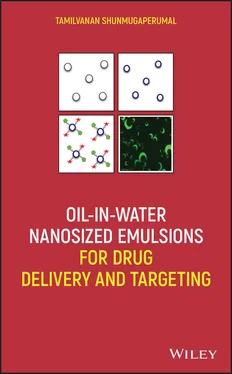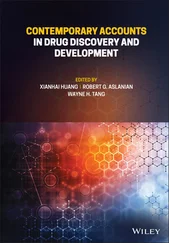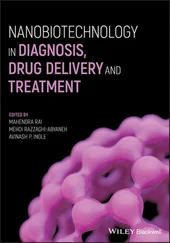Based on the REM analysis, an elaborative risk assessment was carried out by assigning ordinal scores to each MA and PP. Table 2.3displays the details of MAs and PPs employed during FMEA analysis together with their computed RPN scores, which collectively explain their effect and plausible/possible consequences on CQAs of topical ocular emulsions. To discriminate the high‐risk factors against the low‐risk factors, a critical cutoff value of RPN that was fixed for ocular emulsions is 100 or above. With lone exception of probe sonication time (which shows the RPN scores of 18 only), the factors such as amount of chitosan, amount of poloxamer, homogenization time, homogenization speed, premixing time, and volume of castor oil possessed the high RPN scores. The factors associated with high RPN scores were finally subjected to factor screening study by employing the Taguchi design.
Table 2.4shows the selective list of various designs used for optimization and screening of CPPs of o/w nanosized emulsions.
2.5.1.2. Factor Screening Study
The principles of factor sparsity are applied for the factor screening studies in which only a few of the factors among the numerous ones are identified to explain the major proportion of the experimental variation in the final product (Negi et al. 2015). Whereas the active or influential variables were responsible for the major variability, remaining all other factors were termed as inactive, less influential, or simply the noise variables. Based on Eq. (2.1), the CMAs/CPPs that produced high RPN values were finally subjected to factor screening studies to quantitatively estimate the risk associated with the formulation and process variables of topical ophthalmic emulsions. A 7‐factor 8‐run Taguchi design was employed for screening the formulation and process variables of the ophthalmic emulsions. The design matrix was prepared using Design‐Expert ®(version 11.1.0.1, Stat‐Ease Inc., Minneapolis, MN, USA) software. Table 2.5enlists the Taguchi design matrix selected for the preparation of topical ophthalmic emulsions along with the description of their respective low and high levels. A total of eight trial formulations were thus prepared as per the screening design and evaluated for the identified/selected CQAs [mean particle size (MPS), polydispersity index (PDI), and zeta potential (ZP)]. The analysis of the design‐generated data was performed by fitting it to the first‐order linear model obviating the interaction effect(s), while analyzing coefficients for each of the factors. The Half‐normal and Pareto charts were used for quantitatively identifying the effect of each MAs/PPs on the selected CQAs for screening.
TABLE 2.4. Selective List of Various Designs Used for Optimization and Screening of CPPs of O/W Nanosized Emulsion [As Per Design‐Expert® (version 11.1.0.1, Stat‐Ease Inc., Minneapolis, MN, USA) Software]
| Design for |
| Optimization |
Screening |
| Box‐Behnken Central compositeFace centeredOrthogonal quadraticPractical ( k > 5)SphericalRotatable ( k < 6) Miscellaneous3‐Level fractionalHybridPentagonalHexagonal MixtureSimplex latticeSimplex centroid Split‐plotCentral compositeOptimal (custom) Supersaturated |
MiscellaneousIrregular res VPlackett–BurmanTaguchi OA RandomizedMin‐run characterizeMin‐run screenMultilevel categoricOptimal (custom)Regular two‐level Split‐plotMultilevel categoricOptimal (custom)Regular two‐level |
2.5.1.3. Factor Screening Studies by Taguchi Design
To establish the orthogonal effects between formulation or process variables and selected CQAs, the Taguchi design is mainly employed. This design helps not only in filtering the most significant critical variables from the insignificant ones but also in optimizing further the formula for the development of topical ophthalmic emulsions. Figure 2.5a–c depict the Pareto charts for screening of influential formulation and process variables as per Taguchi design using selected CQAs. The standard t limit and Bonferroni limit are depicted as a black line and a red line, respectively, in the Pareto chart. Similarly, the positive and negative effects of each formulation and process variables on each CQAs are also depicted using yellow and blue box in the Pareto chart, respectively.
TABLE 2.5. Taguchi Design Matrix Portraying the Layout of Various Experimental Runs for Factor Screening of Topical Ophthalmic Emulsions
| Critical Material Attributes (CMAs) and Critical Process Parameters (CPPs, also Called as Independent Variables) with Their Code |
Levels |
Critical Quality Attributes (CQAs, also Called as Dependent Variables) |
| Low (−1) |
High (+1) |
| A :Castor oil (ml) |
1 |
2 |
Mean particle size (MPS, nm) Polydispersity index (PDI) Zeta potential (ZP, mV) |
| B :Chitosan (mg) |
6 |
18 |
| C :Poloxamer (mg) |
75 |
100 |
| D :Premixing time (min) |
10 |
15 |
| E :Homogenization time (min) |
15 |
20 |
| F :Homogenization speed (min) |
15,000 |
17,000 |
| G :Probe sonication time (min) |
5 |
10 |
| Run |
A |
B |
C |
D |
E |
F |
G |
| 1 |
1 |
−1 |
1 |
−1 |
1 |
−1 |
1 |
| 2 |
−1 |
1 |
1 |
−1 |
−1 |
1 |
1 |
| 3 |
−1 |
−1 |
−1 |
−1 |
−1 |
−1 |
−1 |
| 4 |
1 |
−1 |
1 |
1 |
−1 |
1 |
−1 |
| 5 |
1 |
1 |
−1 |
−1 |
1 |
1 |
−1 |
| 6 |
−1 |
1 |
1 |
1 |
1 |
−1 |
−1 |
| 7 |
−1 |
−1 |
−1 |
1 |
1 |
1 |
1 |
| 8 |
1 |
1 |
−1 |
1 |
−1 |
−1 |
1 |
If a particular formulation and process variables showed an effect that exceeds the standard t limit in the Pareto chart, then the variables produced a significant effect on the CQAs. On the other side, any of the formulation and process variables showing the effect that is lower than the standard t limit will be considered to produce a nonsignificant influence on the CQAs. In a similar manner, the significances of the formulation and process variables are also determined by the Bonferroni limit in the Pareto chart.
The formulation and process variable such as homogenization speed was found to exceed either t value limit or Bonferroni limit for the MPS ( Fig. 2.5a). This indicates that this formulation and process variable might produce the most significant influence on MPS. Although the homogenization speed was found to produce a significant influence on MPS, it did not influence the PDI and ZP values. Taking the insignificant influence of homogenization speed on PDI and ZP into consideration, the homogenization speed was kept at a constant value of 15,000 rpm. For PDI and ZP, none of the formulation and process variables has shown significant influence ( Fig. 2.5b, c) as they did not cross the t value limit in the Pareto chart. However, the premixing time deliberately omitted and considered as dummy factor since this variable involves in the initial dispersion/mixing of oil and water phases during the emulsion preparation step. The formulation and process variables such as premixing time, homogenization time, homogenization speed, and probe sonication time were decided to fix at constant values of 10 min, 15 min, 15,000 rpm, and 5 min, respectively, due to their insignificant influence on the selected three CQAs of the topical ophthalmic emulsions. By taking our previous experience in making of topical ophthalmic emulsions into consideration, the formulation and process variables such as the amounts of castor oil, chitosan, and poloxamer were, however, selected as critical formulation and process variables that were ultimately needed to be further optimized using the face‐centered CCD.
Читать дальше












